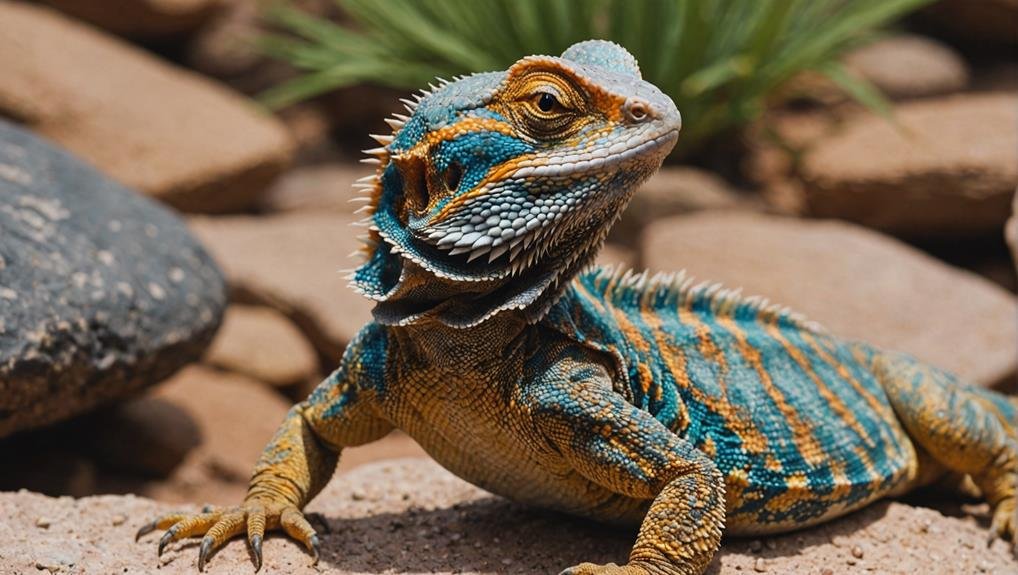If you’ve noticed your bearded dragon’s tail tip turning black and becoming dry or brittle, you might be dealing with tail rot, which requires urgent attention. It would be best if you acted promptly to prevent serious health issues. Understanding the early signs and common causes, such as trauma or bacterial infections, can significantly affect your pet’s well-being. But what exactly should you be looking for, and how can you effectively prevent and treat this condition? Let’s explore the critical steps you should take to guarantee your bearded dragon stays healthy.
Key Takeaways
- Tail rot in bearded dragons is identifiable by blackened tail tips and dry, brittle scales.
- Symptoms include improper shedding, swelling, dryness, and lethargy, necessitating early detection.
- Causes include bacterial infections, trauma, and improper shedding, highlighting the need for preventive care.
- Home treatments involve warm water soaks and antibacterial ointment, while severe cases may require surgical intervention.
- Post-treatment care includes maintaining a clean environment, a balanced diet, and regular veterinary follow-ups.
Identifying Tail Rot
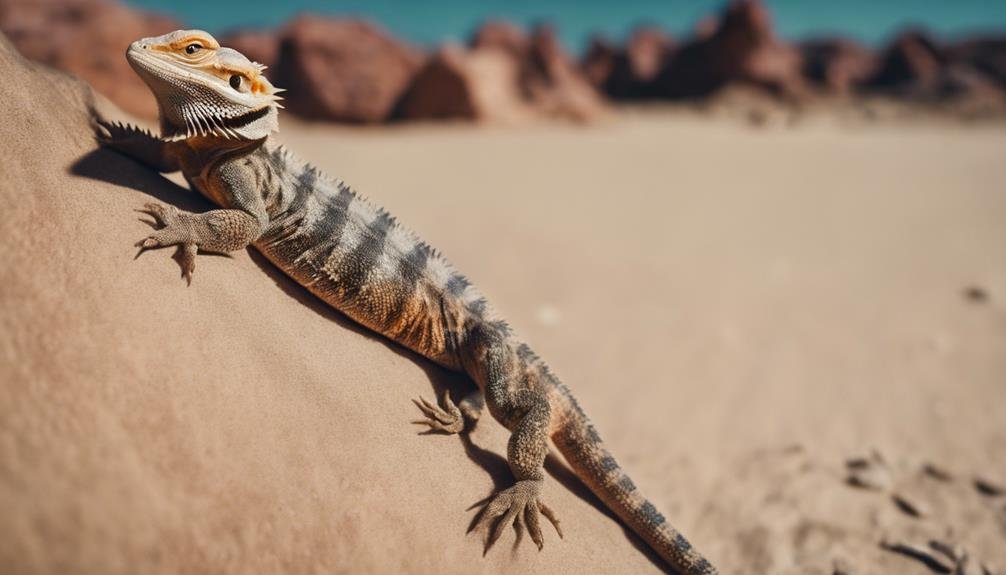

When identifying tail rot in your bearded dragon, look for a blackened tail tip and dry, brittle scales. These are the most critical signs that your bearded dragon’s tail might develop tail rot. The condition often starts at the tip and can progress if not promptly addressed.
Tail rot is typically caused by a bacterial infection resulting from trauma or compromised blood flow to the tail. It is important to monitor your bearded dragon’s tail regularly for any unusual changes. Early identification of these visual cues will allow you to take swift action, potentially saving your pet from further complications.
To ensure a proper diagnosis, consult a veterinarian who specializes in reptiles. They can confirm whether your bearded dragon suffers from tail rot and recommend the appropriate treatment. Regular monitoring and veterinary care are essential in preventing the spread of tail rot.
Don’t ignore these early signs; prompt treatment can make all the difference in your bearded dragon’s health and well-being. Being vigilant and proactive will help ensure your pet remains happy and healthy.
Symptoms to Watch For
Spotting the symptoms of tail rot early can make a significant difference in your bearded dragon’s recovery. One of the most noticeable symptoms is the blackening of the tail, which usually starts at the tip. If you see any darkening, it’s important to take action immediately. Another symptom to watch for is improper shedding. If the tail looks like it’s struggling to shed, it could be a sign of trouble.
If tail rot is left untreated, it can lead to severe health issues. Early detection is essential for successful treatment, as prompt veterinary care can prevent further complications. Here’s a quick reference table to help you identify the symptoms:
| Symptom | Description | Action Needed |
|---|---|---|
| Blackening | Tail darkens, starting at the tip | Seek veterinary care |
| Improper Shedding | Shedding issues specifically on the tail | Monitor and consult a vet |
| Swelling | The tail appears swollen or inflamed | Immediate veterinary visit |
| Dryness | The tail feels unusually dry and brittle | Increase humidity; see a vet |
| Lethargy | General lack of energy or activity | Check overall health |
Don’t ignore these symptoms.
Early Detection Importance
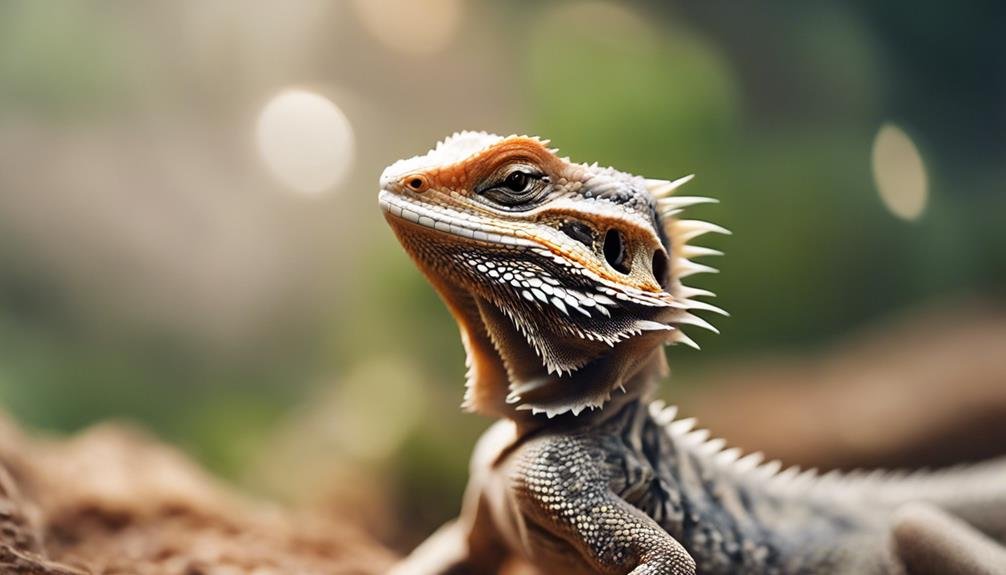

Early detection of tail rot in bearded dragons is vital for preventing severe health complications and ensuring a swift recovery. Catching tail rot in its early stages can greatly reduce the risk of the infection spreading to other parts of the body.
You can avoid severe complications by being vigilant and knowing the signs of tail rot. Signs of tail rot often include blackening of the tail tip, dryness, and a lack of shedding in the affected area. Behavioural changes might also indicate distress. Regularly monitoring your bearded dragon’s tail for abnormalities is essential for detecting tail rot early.
The earlier you spot these signs, the better the chances of a successful treatment. Once you notice any signs of tail rot, immediate veterinary attention is essential. A vet can assess the severity of the condition and recommend the appropriate treatment plan.
Delaying this step can lead to serious health issues for your bearded dragon. Remember, your quick action in detecting tail rot can significantly affect your pet’s health and recovery. Keep a close eye on your dragon’s tail and act swiftly at the first sign of trouble.
Common Causes
Understanding the common causes of tail rot in bearded dragons helps you prevent this painful condition. One primary cause is bacterial infections, which often enter through minor traumas to the tail. Even small cuts or abrasions can become gateways for bacteria, leading to a serious illness if not addressed promptly.
Incomplete shedding is another significant factor. When your dragon doesn’t shed properly, old skin can constrict blood circulation to the tail, causing tissue death and, eventually, tail rot. You must monitor shedding closely and assist if necessary to ensure all the old skin comes off.
Improper diet also plays a role. A lack of essential nutrients weakens your dragon’s immune system, making it more susceptible to infections. Please ensure your pet’s diet is balanced and rich in vitamins and minerals to keep it healthy.
Poor husbandry practices, such as inadequate tank cleanliness, can exacerbate these risks. Dirty environments are breeding grounds for harmful bacteria, increasing the chances of bacterial infections. Keeping the habitat clean and maintaining proper hygiene is essential in preventing tail rot.
Trauma and Injuries
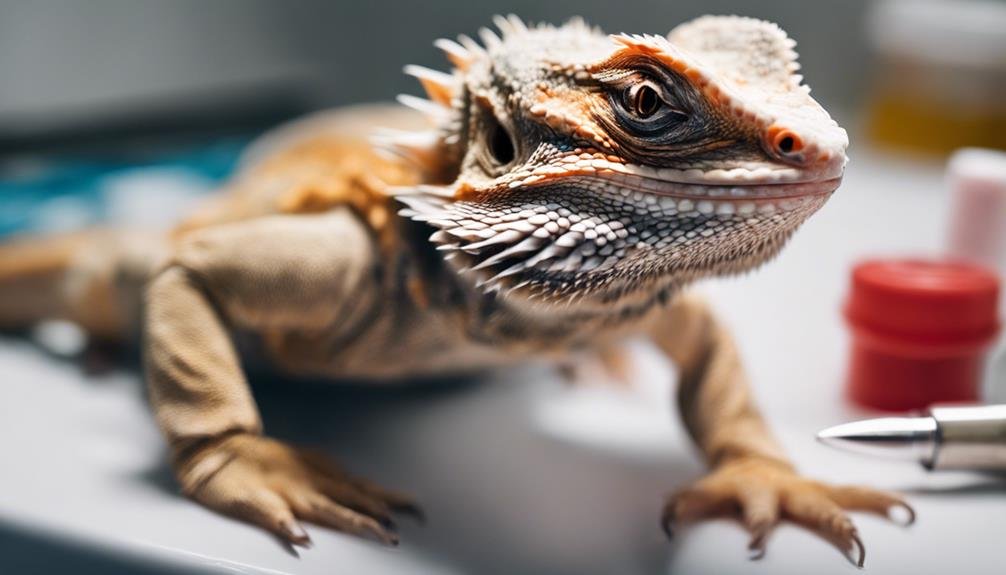

Injuries and trauma are common triggers for tail rot in bearded dragons, often providing an entry point for bacterial infections. When your dragon experiences a bite from a tank mate, an accident, or improper handling, these incidents can compromise the blood flow to its tail, increasing the risk of bacterial infection.
Understanding that prevention is crucial to maintaining your dragon’s tail health and avoiding trauma-related issues.
To prevent trauma and injuries, make sure you’re taking the following steps:
- Proper Handling: Always handle your bearded dragon gently and securely to avoid any accidental drops or squeezes that can cause injury.
- Safe Tank Environment: Provide a tank free from sharp objects and hazards that could injure your dragon. Avoid housing them with aggressive tank mates.
- Regular Monitoring: Frequently check your dragon for any signs of injury or trauma, especially on their tail, to catch potential problems early.
Bacterial Infections
When it comes to bacterial infections, understanding common pathogens like Salmonella is essential.
It would be best to focus on proper treatment and prevention to protect your bearded dragon.
Ensuring a clean habitat and addressing injuries promptly can greatly reduce infection risks.
Common Bacterial Pathogens
Have you ever wondered which bacterial culprits most likely cause tail rot in your bearded dragon?
Tail rot in bearded dragons is often due to infections by common bacterial pathogens. Among these, three notorious bacteria are Pseudomonas, Aeromonas, and Citrobacter species. These bacteria thrive in warm, moist environments, which makes the tail of your bearded dragon particularly susceptible.
Bacteria can invade through wounds, cuts, or abrasions on your dragon’s tail, leading to severe infections if left untreated. Here’s a quick rundown of the main offenders:
- Pseudomonas: Known for its resilience and ability to thrive in various environments, Pseudomonas can cause serious infections that are difficult to treat.
- Aeromonas: Often found in aquatic environments, Aeromonas can easily infect any open wounds on your dragon’s tail.
- Citrobacter: This bacterium is less common but still a significant threat, capable of causing severe tissue damage.
Detecting and addressing these bacterial infections promptly is essential. Maintaining proper hygiene, providing effective wound care, and ensuring a healthy environment can greatly reduce the risk of these pathogens causing tail rot in your bearded dragon. You can help your scaly friend stay happy and healthy by staying vigilant.
Treatment and Prevention
Effective treatment and prevention of bacterial infections in tail rot start with maintaining a clean and dry habitat for your bearded dragon. A pristine environment reduces the risk of bacterial growth, essential for preventing the spread of infections.
When you notice signs of tail rot, such as discolouration or a lack of blood supply, you must take prompt action to treat tail rot effectively.
First, consult a veterinarian for a proper diagnosis and treatment plan. Antibiotics are often prescribed to combat bacterial infections, and they should be administered as directed to prevent the disease from spreading further. In severe cases, surgically removing affected tissue may be required to save your bearded dragon’s body from more extensive damage.
Prevention also involves proper care practices. Ensure your bearded dragon’s tank is regularly cleaned, and any injuries are treated immediately to avoid infection. Ensure that shedding is complete, as incomplete shedding can harbour bacteria.
Regularly inspect your bearded dragon’s body for early signs of tail rot and act swiftly to address any issues. By taking these steps, you can help prevent tail rot and promote a healthy, vibrant life for your bearded dragon.
Prevention Strategies
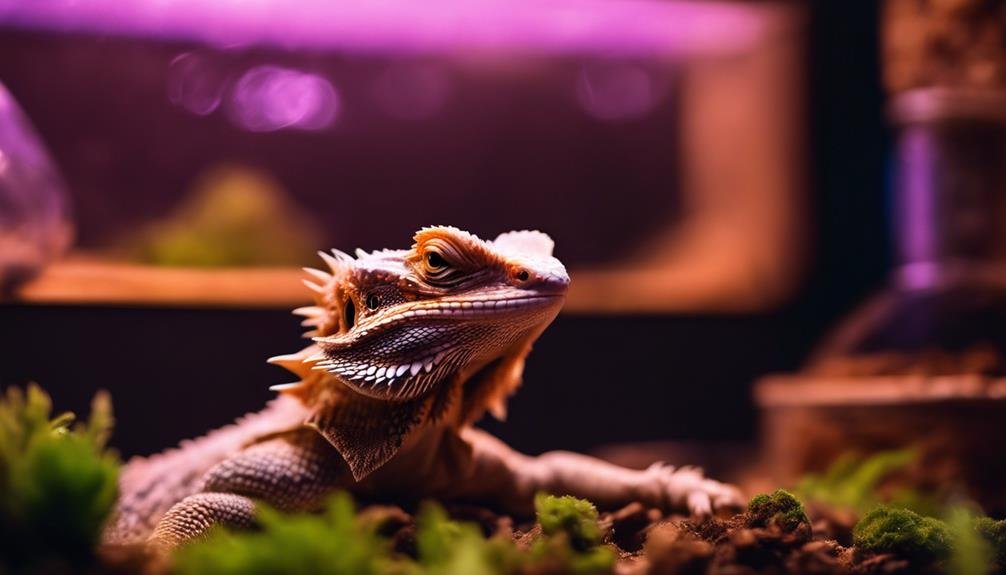

To prevent tail rot in bearded dragons, prioritize maintaining a clean habitat and proper hygiene. Keeping their living environment spotless helps ward off infections that could affect their tail. Cleanliness isn’t just about aesthetics; a dirty tank can be a vital breeding ground for harmful bacteria.
Implement these prevention strategies to maintain your dragon’s health:
- Balanced Diet: Feed your bearded dragon a diet with the right calcium-to-phosphorus ratio to boost their immune system.
- Careful Handling: Handle your dragon gently to avoid trauma and injuries that could lead to tail rot.
- Regular Inspections: Frequently check their tail for discolouration, dryness, or abnormalities.
Ensuring your dragon’s habitat has proper UVB lighting and temperature gradients is another essential aspect of their health. UVB light is critical for calcium metabolism, strengthening their bones and tail. Additionally, the right temperature gradients help digestion and overall well-being, reducing the risk of tail rot.
Home Treatment Methods
To start treating tail rot at home, soak your bearded dragon’s affected tail in warm water mixed with Betadine to clean and disinfect it.
After soaking, an antibacterial ointment like Neosporin is applied to prevent infection.
Warm Water Soaks
It can be an essential and straightforward home remedy when treating tail rot in bearded dragons. It can help soften and remove dead tissue from your dragon’s tail, critical in managing rot. This method also improves blood circulation, promoting faster healing.
First, fill a container with lukewarm water, ideally around 85-90°F, and soak your bearded dragon’s tail for 15-20 minutes. This temperature range prevents thermal burns and guarantees your dragon’s comfort. During the soak, gently massage the tail to help remove debris and encourage tissue regeneration.
Here are some key benefits of using warm water soaks for tail rot:
- Softens and removes dead tissue: Helps eliminate the decayed parts, creating new, healthy tissue.
- Improves blood circulation: Enhances healing by increasing blood flow to the affected area.
- Cost-effective and simple: An accessible and inexpensive treatment at home.
Antibacterial Ointment Application
Consistently applying antibacterial ointment like Neosporin can greatly help treat early stages of tail rot in bearded dragons. This treatment prevents further infection and promotes healing in the affected area. First, clean and disinfect the tail thoroughly before applying the ointment. This step guarantees the ointment is effective in combating the infection.
To apply the ointment, gently spread a thin layer over the affected area. Do this as directed by your veterinarian, usually once or twice daily. Regular application is vital to resolving tail rot. Remember, antibacterial ointment provides a barrier against bacteria, helping the damaged tissue to heal without further complications.
Monitor your bearded dragon’s progress closely. If you notice any worsening symptoms or the tail rot doesn’t improve, consult your vet immediately. Consistent care and vigilance are critical during this treatment phase.
Here’s a quick reference table to guide you through the process:
| Step | Description | Frequency/Notes |
|---|---|---|
| Clean and Disinfect | Thoroughly clean the affected tail area | Before each ointment application |
| Apply Ointment | Spread a thin layer of antibacterial ointment | Once or twice daily, as directed by the vet |
| Monitor Progress | Check for improvement or worsening symptoms | Daily, consult a vet if issues persist |
| Consult Vet | Seek professional advice if necessary | As needed |
Environmental Adjustments
Adjusting the habitat’s temperature and humidity can greatly help manage tail rot in bearded dragons. Ensuring the environment is essential for their healing process. Start by maintaining a basking spot temperature between 95-110°F and cooler areas around 75-85°F. Proper humidity levels should be kept between 20-40%, as excessive moisture can promote bacterial growth, including Salmonella bacteria.
To further enhance recovery, pay attention to these key aspects:
- Clean and Dry Habitat: Regularly clean the enclosure to prevent blood contamination and bacterial infections. Remove the stuck shed promptly, as it can restrict blood supply, leading to tail rot.
- Proper UVB Lighting: Ensure your bearded dragon receives adequate UVB exposure. This is important for their overall health and can aid in regeneration, though they can’t fully regrow their tails.
- Balanced Nutrition: Provide a balanced diet rich in vitamins and minerals to strengthen their immune system and support tissue repair.
Monitor your bearded dragon closely for any signs of improvement or worsening. If the condition doesn’t improve, consult a vet promptly. Implementing these environmental adjustments alongside veterinary guidance can greatly aid in treating tail rot.
Surgical Intervention
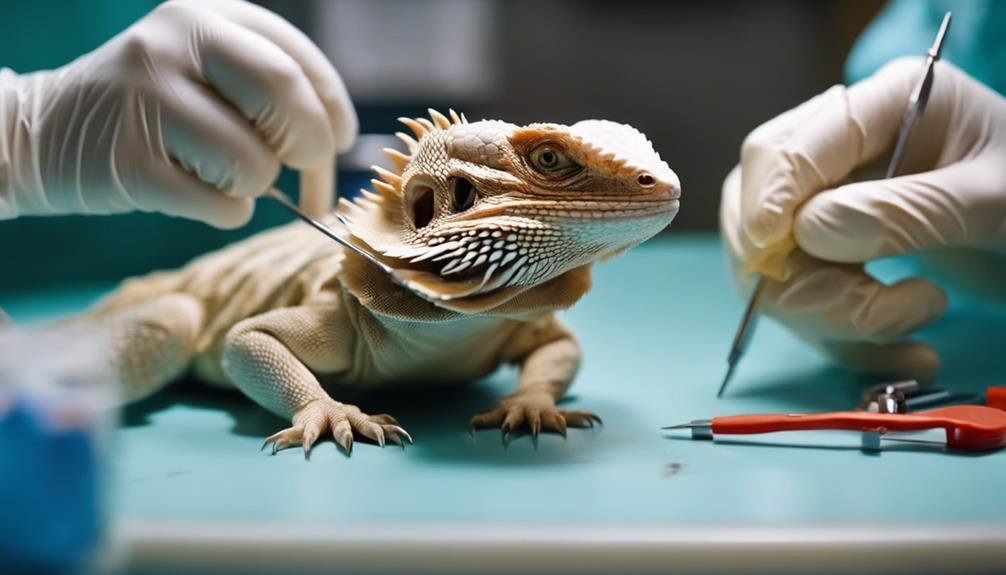

In severe cases of tail rot, surgical intervention may be necessary to amputate the affected part of the tail and halt the spread of infection. The procedure, known as tail amputation, is often the best course of action when the disease has progressed greatly, threatening your bearded dragon’s overall health.
During surgery, a qualified reptile veterinarian will carefully remove the infected tissue to ensure no bacteria remain, preventing further complications. The surgery is performed under anaesthesia to minimize pain and stress for your bearded dragon.
After the procedure, your vet will provide detailed instructions for post-operative care. It’s essential to follow these guidelines closely to guarantee a smooth recovery. Wound management becomes a top priority, involving regular cleaning and monitoring to prevent new infections.
Keep a close eye on your bearded dragon for any signs of infection, such as redness, swelling, or unusual discharge from the wound site. Immediate veterinary attention is necessary if you notice any of these symptoms.
Post-Treatment Care
After your bearded dragon undergoes surgery for tail rot, maintaining a clean and dry environment is extremely important to prevent further infection. Monitoring the affected area regularly is crucial, as well as ensuring proper healing and watching for any signs of recurrence.
Here are some steps you can take to guarantee effective post-treatment care:
- Maintain a clean and dry environment. To reduce the risk of infection, Replace any substrate with a hygienic option like the Geckopia Premium Reptile Liner.
- Provide a balanced diet: Ensure your bearded dragon gets proper nutrition to support recovery. Fresh vegetables, fruits, and appropriate insects can help boost their immune system.
- Follow veterinary recommendations: Adhere to any prescribed medications and schedule follow-up appointments to monitor your pet’s progress.
Post-treatment care for tail rot in bearded dragons doesn’t stop in the physical environment. A balanced diet is essential to speed up recovery. Fresh greens, fruits, and protein-rich insects nourish and help heal.
Lastly, always follow veterinary recommendations for medications and check-ups. Your vet’s guidance is crucial for a successful recovery and preventing future issues. By taking these steps, you’ll help your bearded dragon regain its health and vitality.
Conclusion
By staying vigilant and proactive, you can help your bearded dragon avoid the serious complications of tail rot. Regular inspections, a balanced diet, and proper handling are key to prevention.
If you notice any symptoms, act quickly with home treatments or consult a vet for surgical options. Your prompt attention and care will guarantee your bearded dragon remains healthy and happy, preventing tail rot from becoming a severe issue.
FAQs
1. How Do You Treat Tail Rot in Bearded Dragons?
You treat tail rot with antibiotic treatment, saline soak, and wound care. Make sure the dragon gets dietary supplements to address any calcium deficiency. A clean, dry environment and proper nutrition are vital for recovery. Seek veterinary advice.
2. Is My Bearded Dragon Shedding or Tail Rot?
Check your dragon’s shedding frequency and look for healthy shedding signs. Shedding shows patchy, hydrated skin, while tail discolouration and dry, blackened areas suggest tail rot. Regularly monitor their skin hydration to guarantee overall health.
3. Is Tail Rot Fatal?
Yes, tail rot can be fatal. Early symptoms require immediate veterinary care to avoid potential complications. The recovery process depends on timely intervention. Prevention tips include proper hygiene and regular monitoring to guarantee your pet’s health.
4. Is Reptile Tail Rot Contagious?
Reptile tail rot isn’t contagious. However, it would help if you still practised reptile quarantine to prevent the bacterial spread and avoid fungal infections. Cross-contamination prevention is key in managing any contagious diseases among your reptiles.
Related Article:
https://thereptileguide.com/black-snakes-in-arkansas/
https://thereptileguide.com/rainbow-python-a-colorful-serpent/

